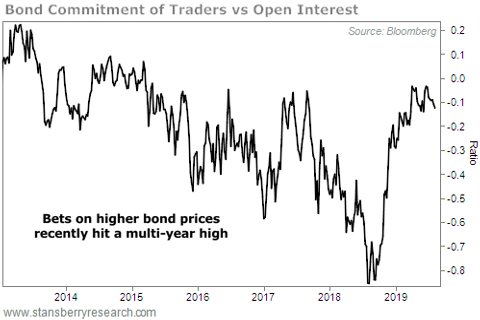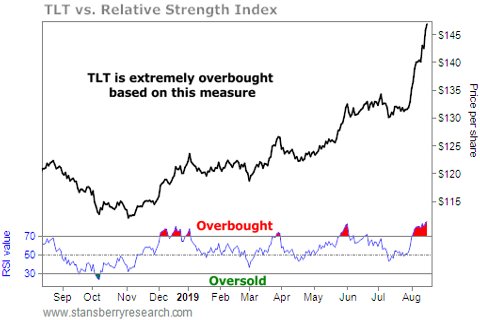
Date: 2025-10-19 Page is: DBtxt003.php txt00017276
Monetary Policy
Negative Interest Rates
It's Official: This Central Bank Policy Is a Disaster
Peter Burgess
The Stansberry Digest
It's official: This central bank policy is a disaster... But we're not worried about negative yields just yet... Investors are 'all-in' on bonds... Why the next big move in interest rates will be up, not down...
Regular Digest readers know we've been highly critical of negative interest rate policy ('NIRP') for years...
Twisted central bankers claimed this policy would boost the economy where merely low or zero-percent interest rates had failed to do so. Yet we've warned that this dangerous 'perversion of capitalism' was sure to fail, too... and risked destroying the banking system in the process.
As it turns out, new research confirms what anyone with a little common sense should have already known. As Bloomberg reported last week...
Central banks' negative interest rates were supposed to increase spending, stop deflation and stimulate the economy. They may have done the exact opposite.Of course, despite these obvious consequences, central bankers haven't 'wised up' yet...
According to research from the University of Bath, central banks charging commercial banks to hold excess cash reserves have actually decreased lending. That's because the additional costs reduce banks' profit margins, leading to a drop in loan growth.
'This is a good example of unintended consequences,' said Dr. Ru Xie of the university's School of Management, one of the study's authors. 'Negative interest rate policy has backfired, particularly in an environment where banks are already struggling with profitability.'
NIRP is still underway in Japan and most of Europe. And this has contributed to a massive rise in negative-yielding debt around the world. At last count, the value of this debt totaled more than $17 trillion – more than double what it was to start the year.
Most of this debt trades in Europe and Japan. However, its rapid growth has led some to worry that U.S. Treasury yields could soon drop below zero, too.
We disagree...
In fact, we believe it's far more likely that long-term rates in the U.S. will move significantly higher over the next several months at least.
Why? There are a couple of important reasons...
First, ineffective or not, it's possible the Federal Reserve might still eventually adopt NIRP, too. However, with short-term rates still above 2% today, this is not an immediate concern.
Meanwhile, the U.S. Treasury bond market is flashing several major warnings signs of an impending decline. And because bond prices and yields (interest rates) move inversely, this suggests rates are likely headed higher.
Our colleague Chris Igou shared a few of these warning signs in the Digest last month...
According to the U.S. government's weekly Commitments of Traders ('COT') report, speculative traders recently became more bullish on Treasury bonds than they have been in years. And that is typically a bad sign for bond prices in the months ahead. As Chris explained...
Futures traders recently hit a multiyear bullish level on bonds...

We saw similar cases in 2013, 2016, and 2017. Each time led to losses in bond prices going forward...
Today, futures traders are 'all in' on higher bond prices. But thanks to these extreme bullish bets, lower bond prices are much more likely.
Chris also explained that 'mom and pop' investors had been rushing to buy bonds, too. More from that Digest...
One of the simplest ways to bet on higher bond funds is through an exchange-traded fund ('ETF'). These funds hold a basket of bonds and allow mom-and-pop investors to easily take part. Today, bond funds are seeing massive inflows of investors buying up shares.
Take the iShares Barclays 20+ Year Treasury Bond Fund (TLT)... TLT holds a basket of long-term Treasury bonds and can create or liquidate shares based on demand. So a falling share count means investors aren't interested... And a rising share count tells us investors are piling into a trade.
Today, shares outstanding for TLT are near all-time highs. Mom-and-pop investors are buying into this strong rally. And shares outstanding have risen roughly 75% since last August.
Finally, he noted that all this buying had pushed this bond fund to its most 'overbought' extreme in over a decade...
TLT just hit the highest 'overbought' level since December 2008...
You know the theme by now... When investors go all-in on an asset like bonds, it's a great time to bet against them.
Another way to see this bullishness is through TLT's extreme overbought levels...
When I say overbought, I'm talking about the Relative Strength Index ('RSI'). It's a contrarian indicator that tells us when investors have gotten ahead of themselves.
And it's a great way to see when a trade has moved too far too fast in either direction.
An RSI level above 70 signals an overreaction to the upside... breaching into overbought territory, while an RSI level below 30 triggers an oversold extreme.
As I write, TLT is in extreme overbought territory. Take a look...

There have only been two other cases when TLT was this overbought – both in 2003 and late 2008... Each instance led to double-digit losses over the next year.
But these extremes aren't the only signs that a bond-market reversal is likely...
In recent weeks, we've noted several others as well...
For example, our friend Jason Goepfert at SentimenTrader noted that his own proprietary sentiment indicator showed that bullishness on U.S. Treasury bonds had reached its second-highest level in history last month.
Another reliable indicator – the Daily Sentiment Index ('DSI'), which tracks sentiment among short-term traders – recently recorded back-to-back days of 98% bulls.
That also was tied for the second most-bullish extreme on record. In fact, the DSI for Treasury bonds has only been higher on one other day in history: December 15, 2008. Prices plunged more than 20% over the next six months... causing the 30-year yield to soar from roughly 2.5% to back over 4.8% by mid-June.
And according to the most recent Bank of America Merrill Lynch Global Fund Manager Survey, professional investors are more bullish on Treasury bonds today than any other time since 2008.
Seeing just one or two of these extremes would give us pause...
But seeing them all flashing together is an unmistakable red flag: Folks have gone 'all in' on Treasury bonds today... And history says it is simply a matter of time before a serious decline begins.
Based on previous extremes, Treasury bond prices could easily fall by 20% or more in the months ahead.
And again, because bond prices and yields move inversely, we could see long-term rates rise from less than 2% today to 4% or more as they do.